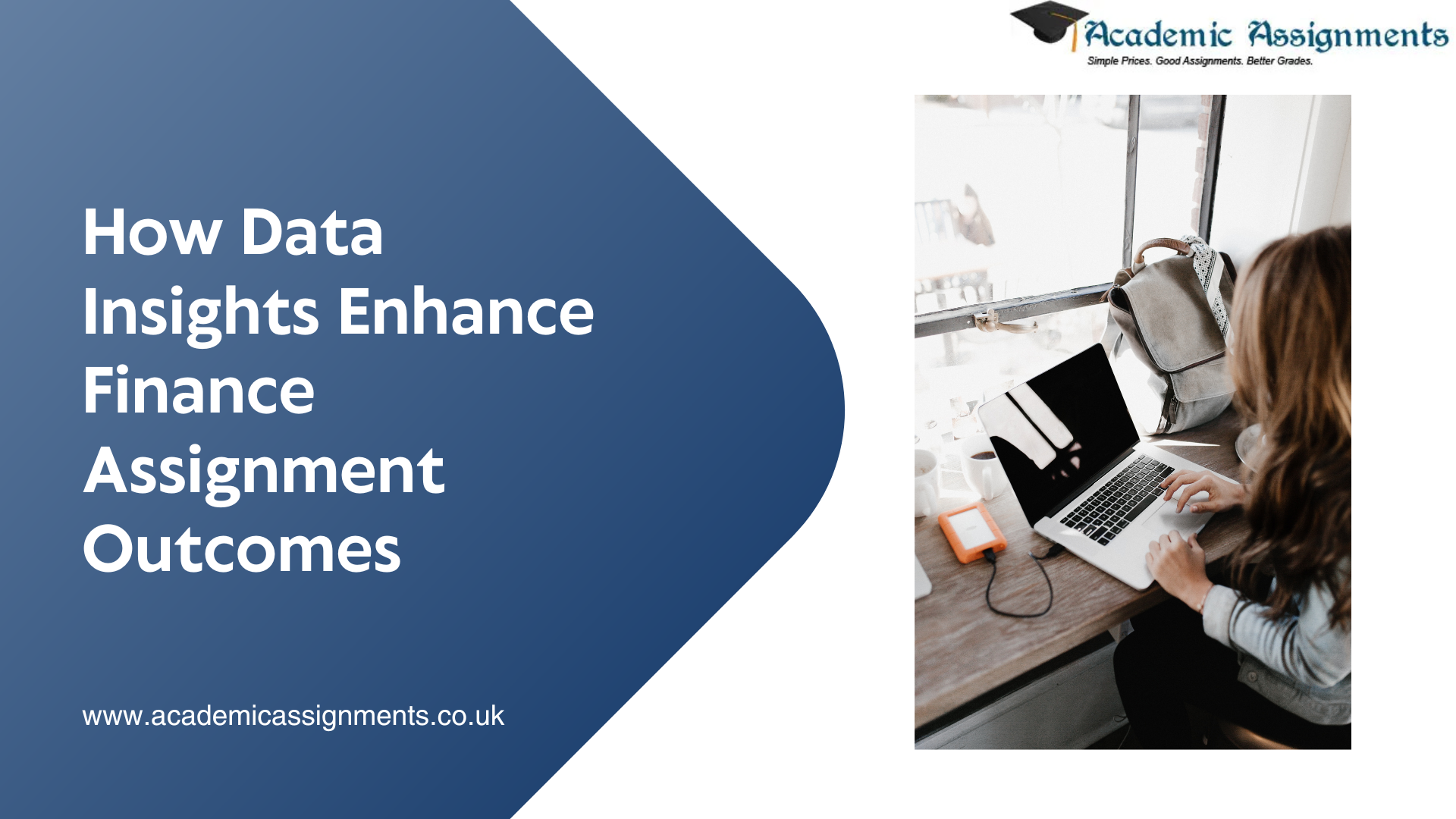How Data Insights Enhance Finance Assignment Outcomes
Currently, most learners have a challenge of how to perform well in their finance assignments. The application of data sciences and Data-driven assignment help has helped in the manner of approaching the process of solving finance-related problems. The use of data not only provides additional knowledge but also ensures the increased quality of the assignments of teachers. This blog post looks at the very important part that data plays in creating optimal finance assignments and examines its value.
Revolutionizing Finance Assignments with Data
In completing Finance assignments, much attention is paid to the conduct of a detailed study of financial trends, patterns of market behavior, and patterns of investment with the assistance of undertaking Finance analytics help. One of the defining factors of today’s business environment as a strategic advantage is the way data can be procured and aanalyzed A student can for instance use financial databases to gather useful trends that might be of importance to that course. For example, current availability that can be found in Bloomberg terminal and Yahoo Finance is real-time. These tools help the students to make correct decisions resulting in correct conclusions.
Data-driven assignments help also ensure that there are few mistakes made when calculating the financial aspects of a business. A study shows that students who apply data-driven assignments realize a 20% better performance compared to learners using traditional methods. In the same prospect, sophisticated modeling conventions such as Excel and Python have made financial modeling easier. With the help of technology, even complex issues have been explained in simple terms to the learners.
The Role of Big Data in Finance
Big data has changed the way things are done especially as it applies to finance assignments. Professional report analysis in this case helps students to view large amounts of information from a learning context in a relatively short time. Through big data, students can investigate trends affecting the financing of corporations. For instance, predictive analytics are utilized to provide financial risk measurement. These insights therefore proved extremely useful for course work that includes risk management strategies. Research conducted by PwC revealed that organizations leveraging big data experience a positive change in decision-making by 60 percent. What the professors are doing is useful because when the students apply the above techniques in their assignments they perform practical standard industry skills.
How Data Enhances Accuracy
Finance assignments are very sensitive and therefore it is very important to be accurate. It only requires a slight manipulation to distort the results from the conclusion which has a significant benefit in transforming the data into the desired result. Through data-driven assignment help, students get to overcome such pitfalls.
For instance, what was once known as financial ratio analysis becomes much more accurate through data intelligence. This situation makes it very different from relying on examples from textbooks; the students can deal with real-time company data. The usage of this approach helps in fleshing up the credibility of the assignment. Further, another method, which involves the help of Finance analytics help is applied to integrate with to raise awareness of its financial performance indicators.
Studies show that while 78% of the students use data-related analysis in finance, they are able to achieve improved clarity levels in their work. Therefore, the data tools are the interconnecting factors between existing knowledge and practice.
Streamlining Financial Reports
Preparation of professional financial reports is often a central task encountered in finance projects. The use of business data writing enhances the organization and flow of such statements. Pupils are free to choose visual data representations such as in the use of SPSS or Tableau.
Particularly if appreciation and commendations are added to the graph and charts, it will enhance assignments. An essay with structures and illustrated works receives better results. Scholarly research for the analysis provides insights that reveal that the assignments where data visualization is included have a 30% boost in feedback reception as compared to many worded documents. Such tools help students present their work in a precise and professional manner.
Practical Case Studies: The Real-World Edge
The use of case analysis is standard in finance assignments. By incorporating data and analytic approaches, the research topics gain improved applicability and richness. For instance, a student, who is working on Tesla and wants to do an assessment of the company’s performance, can use the performance of the company’s shares and/or reports on company profits.
Some of the advantages of using professional report analysis tools include the following: The actual case supported by data displays a student’s capability in analysis. In addition, they assist foster the right attitude toward approaching problems common in the financial industry.
Such insights also help in making scenarios. It makes the assignment more secure because through transferring the student can simulate different financial scenarios. This approach is similar to how a professional determines the possibilities and threats in the markets.
The Effect on Student Outcomes
Computerization of tasks enhances assignment quality as well as the general academic performance of students. A survey reveals that using finance assignment help students get better grades in their assignments by 25% on average. Similarly, peer-reviewed literature reveals that data-driven assignments promote the skill of critical thinking. In solving problems students are taught to be more methodical thus improving their analytical abilities. It also fosters academic success and readiness in approaching professional life exigencies in the long run.
Challenges and Solutions
Implementing data-driven strategies has its challenges as highlighted below. In their coursework, many students are deprived of an opportunity to make use of paid resources in finance or databases. Nevertheless, some of the free resources include Google Finance and any public data set which would be a good starting point. A third challenge is that cumulative training of every model or algorithm takes a lot of time because tools like R or Python are difficult to master. However, tutorials and certification over the online platforms make these tools more available for use. Also, those that provide business data writing services help fill the gap for learners with limited time.
Future Trends in Finance Education
The use of information technology in education is steadily emerging due to the current development of innovative learning tools. Virtual Reality (VR) and Artificial Intelligence (AI) are on the way to taking their place as some of the tools for learning. They offer rich learning environments to finance students. The competition is expected to be led by AI-infused platforms providing data-driven assignment help. All these tools facilitate personalization and, thus, increased understanding of what is taught. Moreover, blockchain technology is being used for data integrity, especially for finance assignments.
Building Financial Models with Data
The use of financial models is an integrated part of many of the assignments given in finance. Students have to produce forecasts, evaluate cash flows for working and fixed capital, and appraise investments. Information increases the reliability of these models significantly. With data-driven assignment help, instead of creating theoretical models, students can build models based on actual data. For instance, the effectiveness of a discounted cash flow (DCF) analysis is increased many times when the actual financial data of companies like Microsoft or Apple are incorporated. Application of tools like Excel, MATLAB, and Python make computations for students as easy as ABC. Additionally, having finance analytics helps to enhance the comprehension of model results so enhancing the standard of the task at hand. The data further reveal that assignments incorporating at least one financial model exhibit a 35% grade increase. Hopefully, the three projects reflect how crucial it is to combine theoretical concepts with practical implementations to create meaningful results.
Enhancing Presentation Quality
In finance assignments, the actual analysis is only half the work with the presentation of findings being of equal importance. Business data writing skills make it possible for students to provide their assignments with relevant information and eye-catching styles. The tools include Tableau, Power BI, and Excel, and these assist students in developing appealing graphs, charts, and infographics. They make the data easier for readers to understand and enhance the professional nature of the assignment at the same time. Research conducted shows that students are 40% more likely to read any work that contains many graphic images. However, using professional report analysis tools, students can see the lacunas and work on improvements in their presentation. It results in brief, meaningful assignments on which target evaluators would wish to report. Highly professional polished presentations combined with accurate data analysis can provide students with solid knowledge in finance together with setting students apart when solving classmates’ and experts’ problems for both the academic and business world.
In totality, what has been found out is that the use of data in finance assignments is not an option, it is compulsory. It is therefore evident that benefits extend to increased accuracy, clarity, and depth of the work. The intention of this retrospective study is for students to incorporate the data skill strategies in enhancing their academic and career achievement. While the education environment is changing, learning these skills will always be the basis for finance education.

 Blogs
Blogs





